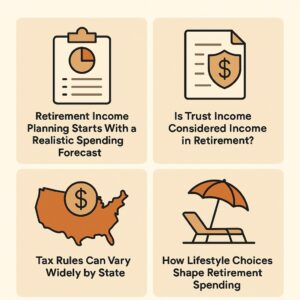Retirement planning often starts with a single number—how much you’ll need to cover monthly expenses. But where that number comes from, and how accurate it turns out to be, varies from person to person. You may have heard rules of thumb like “plan to replace 80% of your working income,” but the truth is more complex.
Some retirees spend less than expected, while others find that healthcare, travel, or inflation push their budget far beyond early estimates. The good news is that your retirement plan doesn’t have to rely on guesswork. With a detailed look at income, taxes, and spending habits, it’s possible to get a much clearer picture.
Retirement Income Planning Starts With a Realistic Spending Forecast
The first step is to understand your fixed and variable costs. Fixed expenses might include housing, insurance, taxes, and basic groceries. Variable expenses often include travel, entertainment, gifts, or home maintenance. What throws people off is how those categories shift over time.
Many retirees spend more in the early years when they’re healthy and active. This phase might include bucket-list travel, home renovations, or supporting adult children. Later phases may see spending slow down, but costs can rise again in your 80s and 90s due to healthcare needs or in-home assistance.
Rather than using a single “replacement ratio,” it’s more useful to map spending over time in stages. A retirement income planning professional can help you model year-by-year cash flow projections that factor in changing needs and inflation.
Is Trust Income Considered Income in Retirement?
Many people use trusts as part of their estate or tax plan, but there’s often confusion around how the distributions from a trust are treated. The answer depends on the type of trust and how it’s structured.
If you’re the beneficiary of a revocable living trust that you created, the assets are still considered yours for tax purposes. Any income generated by those assets—like interest, dividends, or capital gains—will appear on your personal return. You’re free to use that income in retirement, but it won’t feel different from drawing income from a regular brokerage account.
If you’re receiving income from an irrevocable trust that someone else created, it’s a bit different. In most cases, distributions made to you from that trust count as taxable income to the extent that the trust earned income in the same year. For example, if the trust earned $10,000 in dividends and distributed $10,000 to you, you would likely owe tax on that amount. However, distributions of principal (the original amount placed in the trust) are generally not taxed.
From a budgeting perspective, you’ll want to include predictable trust income as part of your retirement cash flow. If the amounts vary, or the trust has discretion over when to distribute funds, then you may want to treat it as supplemental rather than core income.
Tax Rules Can Vary Widely by State
Even if your spending stays consistent, where you live can affect how much you keep after taxes. Income tax rules vary significantly from state to state, and that includes how retirement income is treated.
Washington State has no personal income tax. That means Social Security, IRA distributions, pension income, and trust income are not taxed at the state level. This makes Washington an attractive choice for retirees who expect to draw most of their income from traditional retirement accounts. However, keep in mind that Washington does have high sales taxes and property taxes in many counties, which can affect your cost of living in other ways.
South Carolina takes a different approach. It does have a state income tax, but it’s generally considered tax-friendly for retirees. Social Security is not taxed, and there are generous deductions for other types of retirement income. For example, taxpayers over 65 can deduct up to $10,000 of retirement income per person. South Carolina also offers a homestead exemption for homeowners over 65, reducing property taxes on primary residences.
When evaluating whether to move or stay put in retirement, it’s not just about climate or proximity to family. The tax impact of withdrawals, trust income, and investment gains can vary widely depending on your zip code.
How Lifestyle Choices Shape Retirement Spending
Beyond taxes and healthcare, your lifestyle plays a major role in how much you’ll actually spend. Some people downsize, cook at home, and travel occasionally. Others join country clubs, dine out, and plan annual international trips. Neither approach is wrong—but they require different levels of income support.
It also helps to think through your goals. Are you hoping to fund grandchildren’s college? Leave a charitable legacy? Age in place with help from caregivers? These priorities affect not only how much you need, but when you need it.
Another factor to consider is how much flexibility you’re comfortable building into your plan. Some retirees like having a large cash buffer. Others prefer investing more aggressively and adjusting their withdrawals as needed.
You Don’t Need to Guess
There’s no magic number that applies to everyone. One couple might need $4,000 a month to live comfortably, while another needs $10,000. Your personal spending habits, location, taxes, and health all play into the equation.
Chris Maggio at Retirement Planning Partner helps clients replace the guesswork with data. That includes building a year-by-year projection of retirement income, identifying tax-saving opportunities, and helping you understand what spending may look like at each stage of life.
If you’re planning for retirement without a clear idea of how much you’ll actually spend, now is the right time to get clarity. The surprises are easier to manage when you can see them coming.





Leave a Reply